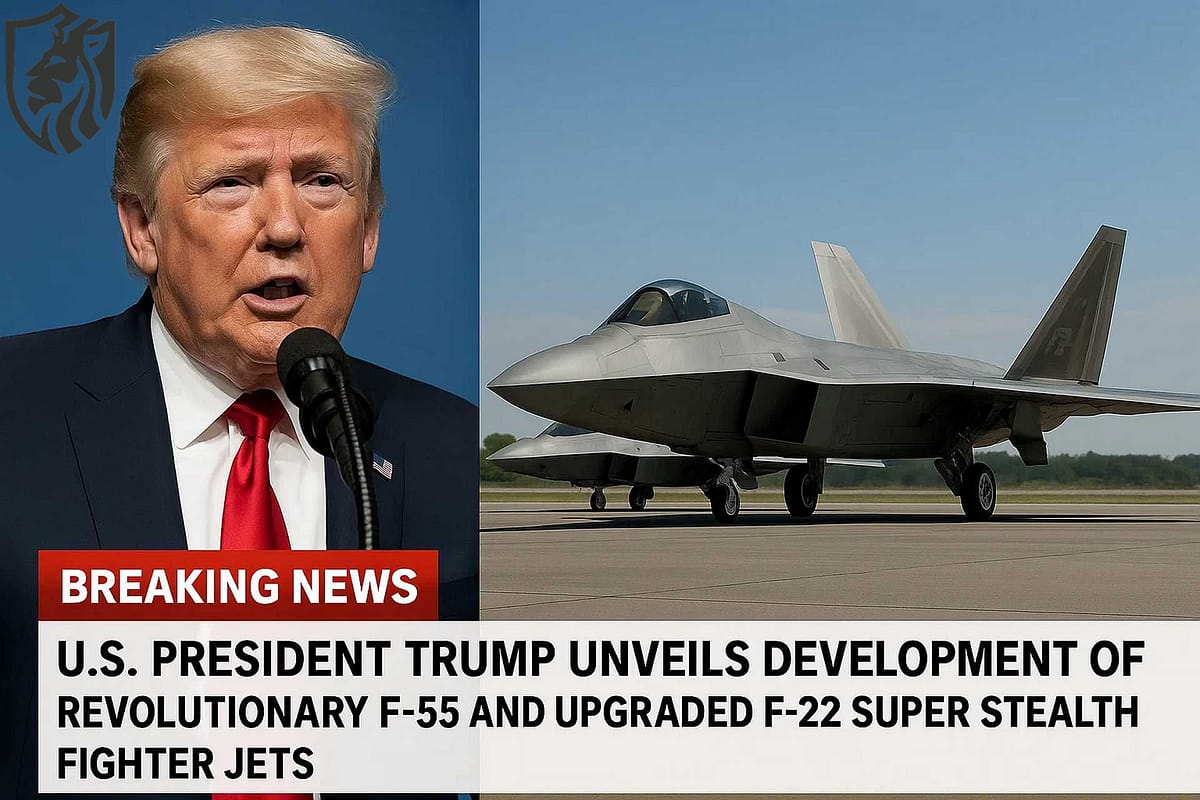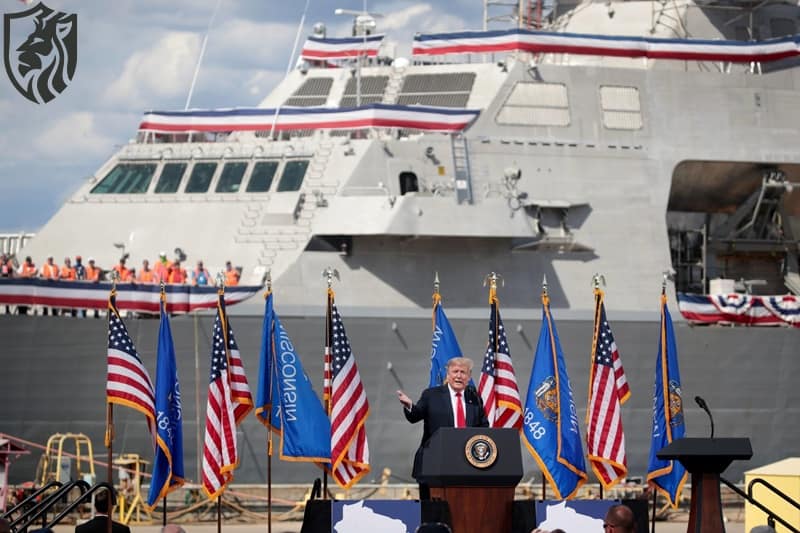
U.S. President Trump Unveils Development of Revolutionary F-55 and F-22 Super Stealth Fighter Jets.
On Thursday, President Donald Trump spoke to U.S. military personnel and business leaders at Al Udeid Air Base in Qatar, where he unveiled designs for a new twin-engine fighter plane, the F-55, and a major upgrade of the Lockheed Martin F-22 Raptor, officially the F-22 Super.
The news came as part of a four-day Middle East tour amid rising global competition for air dominance and controversy over U.S. defense budgets.
Little information is available, but the new planes may signal a change in the Pentagon’s strategy for protecting U.S. air dominance from would-be adversaries like China and Russia.
The uncertainty surrounding the design of the F-55 and its meaning in comparison to current programs has raised questions about whether or not such programs are real improvements or just political maneuvers meant to appeal to popular opinion.
Trump’s remarks underscored the necessity for advanced technology to enhance the capabilities of America’s air forces, in a setting reminiscent of a rally at Al Udeid, the country’s largest Middle East base.
He said, “We’ll have an F-55, and if we can get the price, that’ll be two engines and a super upgrade on the F-35.”
The world’s most beautiful fighter plane
He also praised the F-22 as “the world’s most beautiful fighter plane” and vowed the availability of a “very modern version” via the F-22 Super upgrade.
The statement was consistent with Qatar’s undertaking to spend $10 billion on Al Udeid and $42 billion on defense purchases, underscoring the strategic partnership of the two nations.

Trump exclaimed that the F-55 is a significant departure from the single-engine Lockheed Martin F-35 Lightning II, which has been the mainstay of the U.S. and allied nations’ air forces for over ten years.
The F-35, which the Pentagon planned to use as an air-to-air fighter, an attack aircraft for ground targets, and an electronic warfare platform, is powered with a single Pratt & Whitney F135 engine.
The stealth capabilities of the aircraft, advanced sensors like the AN/APG-81 radar, and network-centric warfare capabilities have made it a key piece of the United States Air Force, Navy, and Marine Corps, as well as allied nations like the United Kingdom and Japan.
But Trump’s loud endorsement of a two-engine F-55 version suggests a very different airplane, perhaps along the lines of the Navy’s F/A-XX program, seeking to introduce in the 2030s a sixth-generation replacement for the F/A-18E/F Super Hornet.
F-35’s single-engine design
A twin-engine design has survivability and reliability benefits, especially for extended over-water flights in hostile airspace such as the Pacific, where engine loss would be disastrous.
Some have criticized the F-35’s single-engine design for being less safe for high-threat missions, despite its lighter weight and lower cost. Trump alluded to this issue, saying, “I don’t like single engines,” and citing that the F-55 would be more reliable due to its dual engines.
Although the details about the F-55 are not yet available, it is being called a “super upgrade” of the F-35, leading to guesses that it will include new technologies from the Next Generation Air Dominance [NGAD] program, which is a secret Air Force project aimed at creating a range of systems that includes both piloted fighter jets and unmanned Collaborative Combat Aircraft [CCA].
The Navy-led F/A-XX program prioritizes advanced stealth, long-range strike, and seamless integration with autonomous unmanned air systems.
Official Department of Defense reports indicate that the F/A-XX will have advanced sensors such as multi-spectral radar systems and infrared search-and-track systems, which are especially effective at detecting difficult-to-detect targets at long ranges.
The program also focuses on directed-energy weapons, such as lasers, and hypersonic missiles to counter emerging air defenses. Northrop Grumman and Boeing are vying for the contract, with the award originally scheduled for March 2025 but postponed due to budget considerations.
Pete Hegseth
The three-year delay proposal by Defense Secretary Pete Hegseth has added to doubts over its feasibility and whether the F-55 is a re-skinned F/A-XX or a fresh program.
The F-22 Super Raptor, on the other hand, is designed to revitalize the Air Force’s main fighter for air superiority. The F-22, which was first flown in 2005, is still the most agile and stealthy because of its twin Pratt & Whitney F119 engines and low-observable technology.
Its AN/APG-77 radar and supercruise capability—extended supersonic flight without afterburning—enable it to excel in air-to-air combat.
But the fleet, limited to 187 aircraft because of cost, has struggled to integrate advanced technologies such as helmet-mounted displays and open-architecture avionics used in newer aircraft such as the F-35.
Lockheed Martin has proposed the TacIRST infrared sensor for more accurate targeting. They also offer stealth coatings to counter advanced enemy radar systems.
Trump’s mention of the F-22 Super recalls the Navy’s F/A-18 Super Hornet upgrades. That aircraft saw major improvements in avionics, sensors, and weapon systems over time.
Lockheed Martin
Lockheed Martin left the NGAD competition in 2024, shifting focus to upgrading existing platforms. CEO Jim Taiclet confirmed NGAD technologies would enhance the F-35 and F-22 fleets.
Potential upgrades include advanced data links for controlling CCA drones in complex missions. Other enhancements may feature an upgraded AN/APG-77[V]1 radar for greater detection range.
Interoperability with hypersonic missiles like the AGM-183A ARRW is also under consideration. These changes could make the F-22 Super a bridge to sixth-generation fighters.
Such upgrades aim to outpace China’s J-20 and Russia’s Su-57 fighters. Both competing forces deploy advanced sensors and long-range missile technology.
Al Udeid Air Base has been vital for US operations in the Middle East since 1996. Located southwest of Doha, it houses over 10,000 US troops.
It also serves as the forward command post for US Central Command. The base supported air strikes in Iraq and Afghanistan. It also helped evacuate personnel from Afghanistan in 2021. In 2019, Al Udeid deployed F-22s to deter Iranian aggression.
F-55 or F-22 Super
The jets proved they could stay undetected in contested airspace. Qatar has pledged $10 billion to upgrade the base’s infrastructure. This investment could make it a proving ground for the F-55 or F-22 Super. In 2013, an F-22 intercepted an Iranian F-4 Phantom over the Persian Gulf.
The Raptor’s stealth let it approach undetected, forcing the Iranian jet to withdraw. This showed the F-22’s unmatched control of contested airspace.
The F-22 Super aims to improve this advantage with advanced sensors and weapons. The F-55 could expand such missions into areas like the South China Sea.
There, China’s S-400 defenses and J-20 fighters present tough challenges. China’s J-20, in service since 2017, boasts stealth, supercruise, and long-range PL-15 missiles.
The J-36, still in development, focuses on long-endurance missions and drone integration. Russia’s Su-57 features advanced avionics and hypersonic capability but lags in stealth.
Europe’s FCAS and GCAP projects target sixth-generation fighters by the mid-2030s. These will likely feature directed-energy weapons and artificial intelligence systems.
The competition for control of future air war is intensifying, compelling the U.S. to deliver on initiatives like the F-55.

NGAD-related program
Trump also mentioned the F-47, a new air dominance fighter ordered from Boeing, though little information is available. The mention may be for an NGAD-related program or an error for another aircraft.
Boeing’s recent achievements in procurement, such as Qatar’s purchase of 160 commercial planes, indicate that the company is strategically well positioned to spearhead future military endeavors.
However, the concurrent initiative to develop the F-55, F-22 Super, and F-47 raises concerns about cost-effectiveness.
One NGAD fighter will cost more than $300 million, and budget issues have already pushed back F/A-XX and NGAD.
Hegseth’s call to push back F/A-XX by three years is an indication of the pressures the Pentagon, Congress, and the White House are feeling regarding defense priorities.
Qatar’s status as a strategic ally puts another dimension on the statement. The Gulf state has hosted significant talks, such as those between Hamas and Israel, and hosts vital American military resources at Al Udeid.
Its $42 billion in defense transactions, agreed on during Trump’s trip, includes armed long-range drones, according to The Telegraph.
U.S.-Qatari relations
These transactions highlight U.S.-Qatari relations, which would fund new projects such as the F-55. However, some have criticized the secrecy surrounding the F-55’s specifications and timeline.
Unlike the F-35, which faced years of public scrutiny, the F-55 emerged suddenly and unexpectedly. Its surprise reveal suggests it may still be in early concept stages, aiming to rally political and allied backing.
The US defense industry faces rising pressure to keep its technological edge in a competitive global environment. Budget cuts have slowed the F/A-XX program, limiting progress and stretching development timelines.
Lockheed Martin’s exit from the NGAD program highlights the massive risks tied to next-generation fighter development. Future fighter designs may integrate autonomous platforms like CCA drones to boost battlefield capabilities.
These drones could overwhelm enemy defenses through coordinated piloted-unmanned missions. The F-55 and F-22 Super may allow pilots to command drone swarms in combat.
Such drones could perform reconnaissance, jam radars, or launch precision strikes. However, without clear budgets and technical plans, these projects risk major delays.
Al Udeid
The F-35’s decades-long development challenges serve as a cautionary reminder. At Al Udeid, Trump spoke of broader military goals beyond the F-35 program.
He promised troop pay raises and rejected past patterns of foreign intervention. Defense Secretary Pete Hegseth introduced Trump at the event, setting the stage for strong policy statements.
Trump blamed global problems on what he called “wokeness and weakness”. He pledged to restore the “peace through strength” doctrine as a guiding principle.
Al Udeid’s role in operations against Yemen’s Houthis shows its strategic importance. It also supports humanitarian aid deliveries to Gaza, reinforcing its dual purpose. The combination makes it an ideal hub for ambitious defense initiatives.
Conclusion
As the United States navigates a complex geopolitical environment, the F-55 and F-22 Super represent a potential resource and unknowns.
A twin-engine fighter and an advanced Raptor can recapture air supremacy leadership, particularly in light of China’s growing presence in the Pacific. However, the lack of specifics and ongoing budgetary disputes raise doubts about the viability of the F-55 and F-22 Super.
The Pentagon’s power to translate Trump’s vision into actionable operations will rely on meticulous planning and wide-ranging agreement with Congress.
The defense community is currently awaiting further clarification, questioning whether the F-55 represents a new era or merely the unfulfilled promises of past years.
References
- Defense News Today – defensenewstoday.info
- U.S. Air Force – F-22 Overview – af.mil/F-22
- Lockheed Martin – F-35 – lockheedmartin.com/F-35
- Breaking Defense – NGAD – breakingdefense.com/NGAD
- The Telegraph – Qatar Defence – telegraph.co.uk
- U.S. Department of Defense – defense.gov
- The War Zone – NGAD & F/A-XX – thedrive.com/the-war-zone








